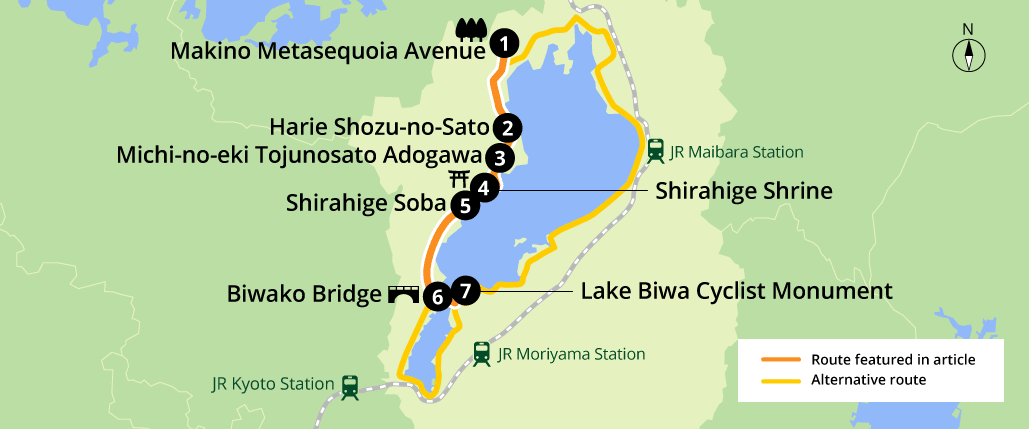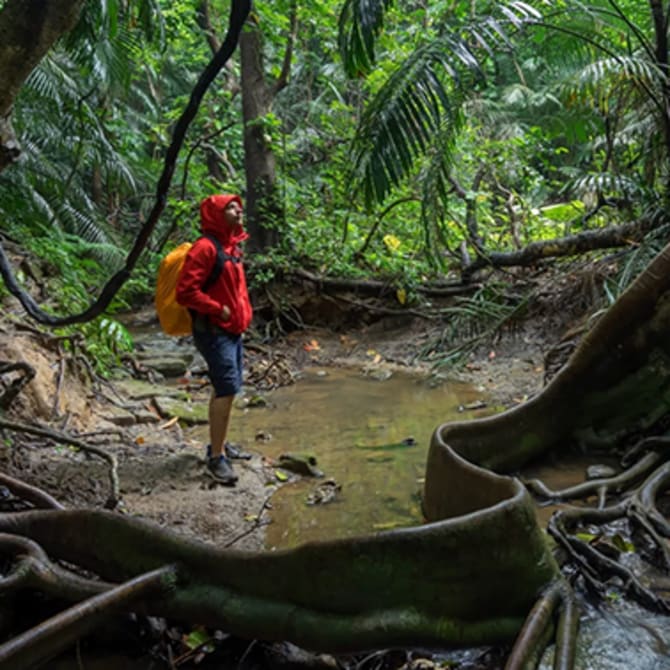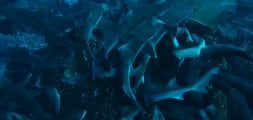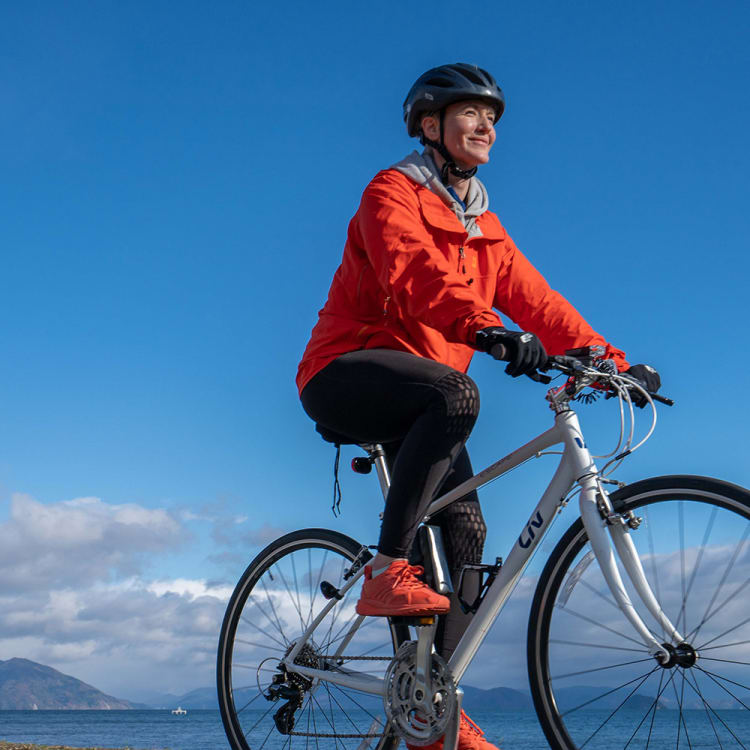
Travel Logs Cultural Immersion on a Lake Biwa Biking Trail
Within an hour of leaving Kyoto, you can feel the breeze through your hair and the sun on your face as you cycle along the shores of Japan’s largest freshwater lake, Lake Biwa. An escape to the countryside provides a great contrast to the traditional streets of Japan’s ancient capital.
Explore a historic corner of Japan on two wheels
Biwaichi is one of the country’s designated National Cycle Routes. It is in Shiga Prefecture, and allows you to cycle around the circumference of Lake Biwa, the largest freshwater lake in Japan. This 200-kilometer-long cycling path is well-marked and easy-to-navigate, designated by blue lines around the shore. If you want to explore a little deeper and see the area through the eyes of a local, a guided cycling trip is the best way to go. The opted course for this journey was a 50-kilometer-long, beginner-friendly section on the west side of the lake.
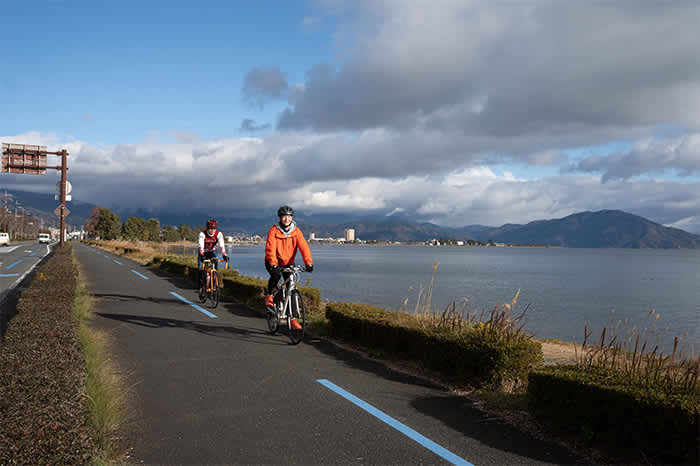
Beautiful views of Lake Biwa

Signage is easy to follow along the entire Biwaichi route
We started our trip just after sunrise on a chilly morning in early December at Metasequoia Avenue. This 2.4-kilometer-long, arrow-straight stretch of road is lined on both sides with 500 towering dawn redwoods, all of which were a shade of burnt apricot under the late autumn sun. Beyond the trees, we caught glimpses of the misty peaks of the Makino Highlands in the distance. Even at this early hour the avenue was busy with people trying to get the perfect seasonal shot for their Instagram feed. The day certainly got off to a spectacular start.

Towering dawn redwoods in autumn colors
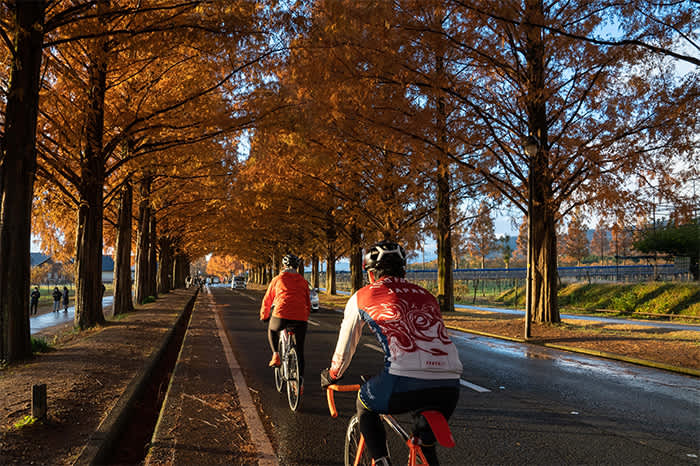
Metasequoia Avenue in late autumn
We cycled onward towards Lake Biwa , with the calm, clear vastness of the lake spread out in front of us. Japanese pine trees dotted the shore, and as we cycled I spotted coots bobbing on the gentle waves, herons keeping watch for fish, and black kites soaring overhead. It was a tranquil setting; the whirr of the bikes’ wheels, the occasional click of a gear change, and the breeze blowing through the trees were the only sounds.

The calm surface of Lake Biwa

Blue skies and blue waters
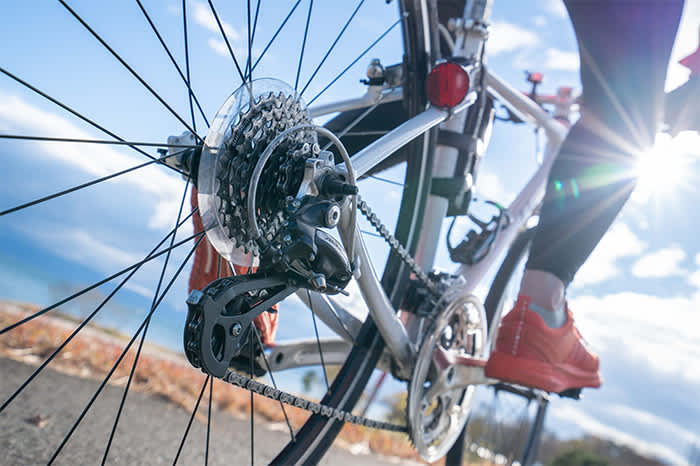
Hit the road on two wheels
We turned off the cycle path after about 14 kilometers, heading along some rural back roads. I stopped to take photos; landscapes of yellowing rice fields and traditional houses with black-tiled roofs, and scenes from village life. As we rounded another corner, I audibly gasped. The village of Harie Shozu-no-Sato is utterly charming. We slowed our pace as we cycled past pretty shrines, a wooden water mill slowly churning in a stream, traditional homes, and gardens filled with veggies.

Autumnal scenery around Lake Biwa
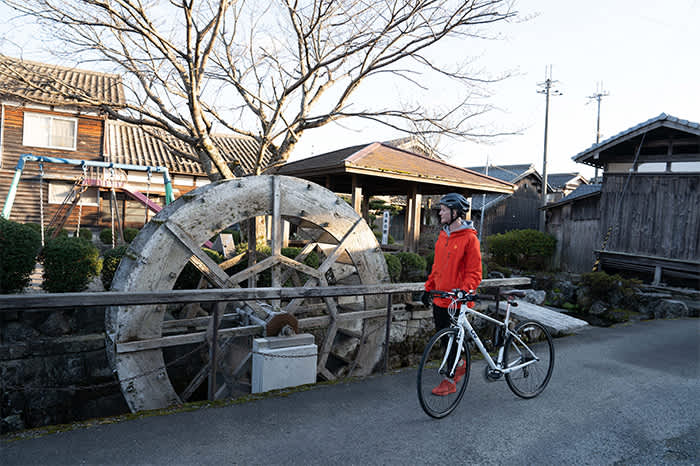
The wooden water mill of Harie Shozu-no-Sato
This little village has more than 100 springs, which have defined the way of life for locals for centuries. The community makes use of a rare waterway system called kabata, a network of interconnected water stations which utilizes the area’s springs. Many visit to witness this unique lifestyle, but in order to tour around the community, you’ll need to make a reservation before visiting and pay a fee for a tour of the village.
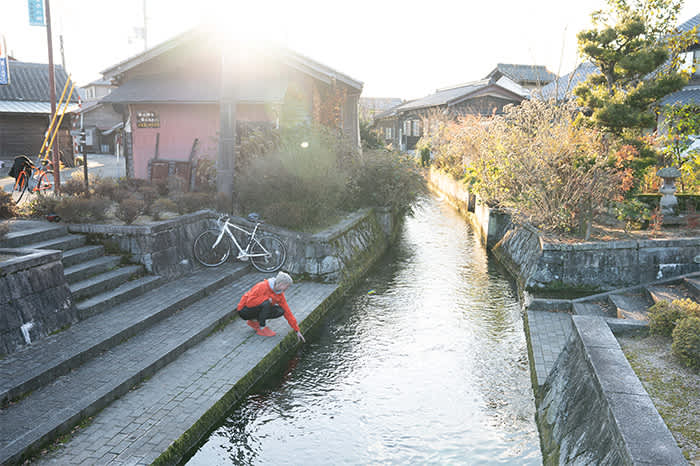

The clean, pretty waterways of Harie Shozu-no-Sato
A further 5-kilometer ride through rice fields took us to Michi-no-eki Adogawa, where we stopped for a rest and mid-morning refreshments. This roadside station has an indoor farmers’ market where you can shop for handicrafts, local veggies, and sweets made from regional produce. The cycling guide suggested hydrating with a bottle of Adoberry soda, a sweet pick-me-up after a long cycle. “Adoberry” is the local nickname for boysenberries, a cross between raspberries, blackberries, dewberries, and loganberries. These berries are not commonly grown in Japan, and are difficult to find outside of the Adogawa area. We used this opportunity to buy some Adoberry sweets for the ride, and some jams, sauces, and biscuits as souvenirs.

Adoberry drinks on the shelf at Michi-no-eki Adogawa
After another 4-kilometer stretch we reached a district of historic buildings, which felt like a living museum. The aging wooden buildings house bakeries, cafes, and sake breweries. Look out for the sugidama cedar ball hanging outside a sake brewery, which traditionally meant a fresh batch of sake was brewing. The cycling guide tipped me off about a centuries-old shop in the village that sells funazushi, a local style of sushi using fish that has been fermented for three years. It’s an acquired taste, but one sushi-lovers shouldn’t miss the opportunity to try.

Cycling past a sugidama cedar ball outside a traditional sake brewery
We hopped back on our bikes to cycle a further 3-kilometers to the most iconic spot around Lake Biwa, 2,000-year-old Shirahige Shrine. The location of the shrine is marked by a striking red torii gate that rises from the water and appears to float on the lake. There is nowhere to stop along the water’s edge to take photos, but you can view the gate from grounds of the shrine on the opposite side of the road, or while cycling past. We stopped to visit the shrine and make a small offering to pray for good fortune.
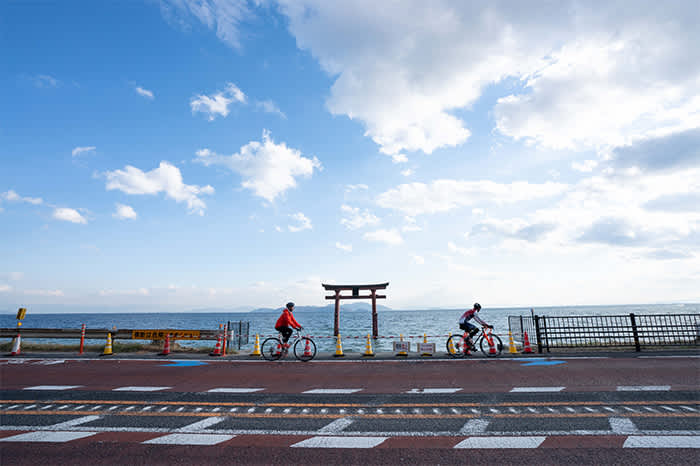
The red torii of Shirahige Shrine rising from the lake
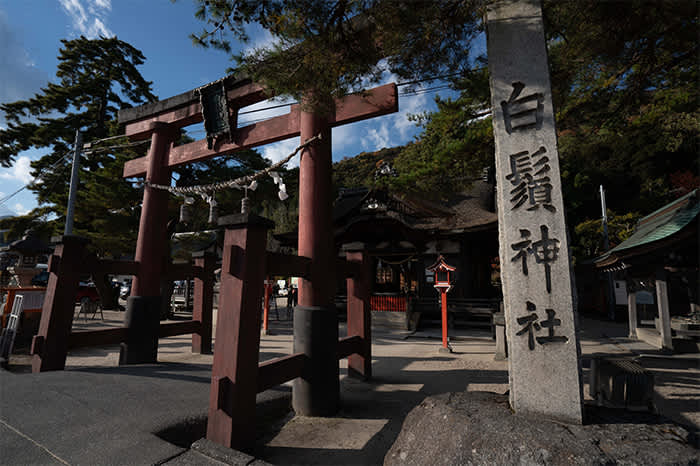
The torii at the entrance to the shrine

Exploring the grounds of Shirahige Shrine, an iconic sight at Lake Biwa
It felt like our prayers were answered almost immediately, as a few hundred meters along the road the cycling guide pointed out his favorite spot to refuel. The first thing that struck me about the restaurant, Shirahige Soba, was its incredible views of Lake Biwa. We headed directly to the veranda, to a counter facing out to the lake. A heater under the counter took the edge off the cool breeze, and soothing background music created a tranquil atmosphere.
We opted for a restaurant original; a hearty and delicious set that came with Shirahige bukkake soba and mackerel sushi. The soba is topped with thinly sliced Japanese spring onions, sweet, deep-fried bean curd, and sesame chili oil.

Enjoy tranquil views of the lake at Shirahige Soba
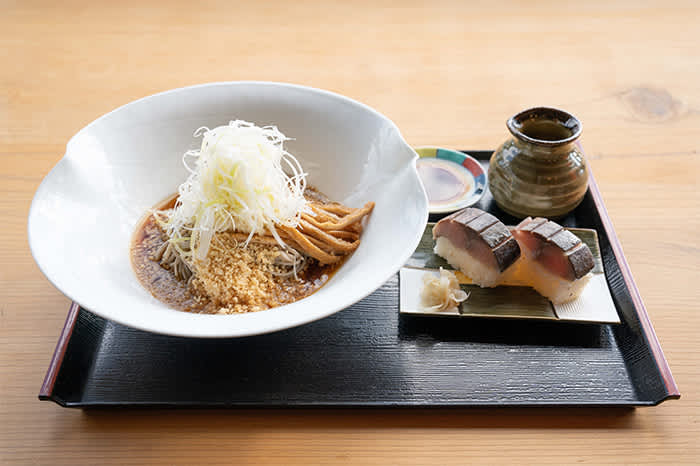
Fuel stop at Shirahige Soba
With a belly full of food, we hopped back on the bikes for the longest stretch of our trip. For about an hour we cruised along narrow roads that hugged the shoreline. We passed by idyllic scenes of farmers harvesting grasses to thatch nearby roofs, as well as pretty lakeside camping grounds.

Charting out our course

Late autumn foliage adorn the mountains

Harvesting reeds along the lake’s shore
As we approached the south side of the lake, the countryside gave way to more urban environs. Biwako Bridge looming ahead signaled that we were nearing the end of our trip. I was grateful for my bike’s gears as we made our way over the bridge. From the midway point, we surveyed the landscape and appreciated just how far our legs had taken us. Windsurfers glided across Lake Biwa’s waters, and my guide pointed out Okishima, a sparsely inhabited island in the middle of the lake, in the distance.

Sightseeing from the top of Biwako Bridge
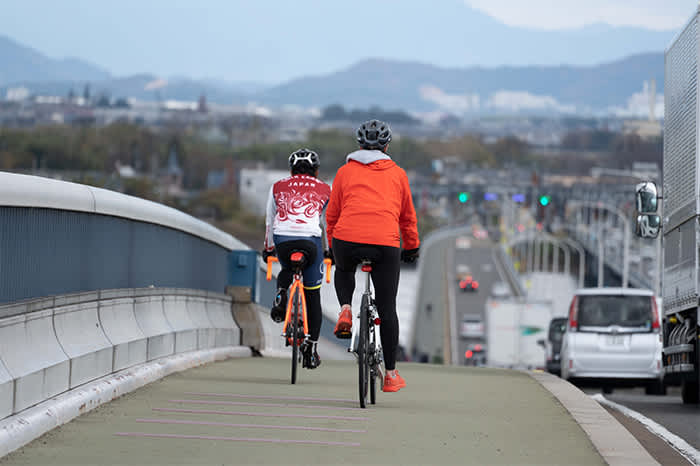
The final stretch of the tour
From here, we were on the home stretch to the Lake Biwa Cyclist Monument, a small statue of a cyclist on the lakeshore. It’s a fitting spot to commemorate the trip with a photo, and take one last look over the lake.
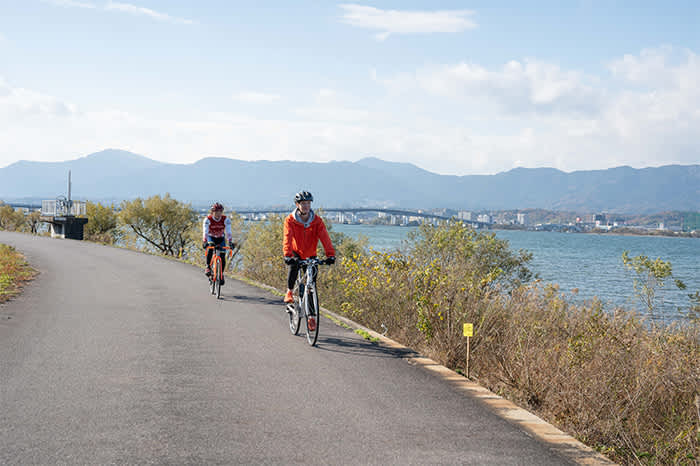
Biwako Bridge behind us as we cycle towards our goal

Take one last look over the lake at the Lake Biwa Cyclist Monument
Having seen many of Japan’s major sights, Lake Biwa had everything I was looking for; an off-the-beaten-track vibe, with plenty of opportunities to explore a more authentic side of Japan. It is the perfect place to enjoy nature, culture, tasty local food, and serene cycling.
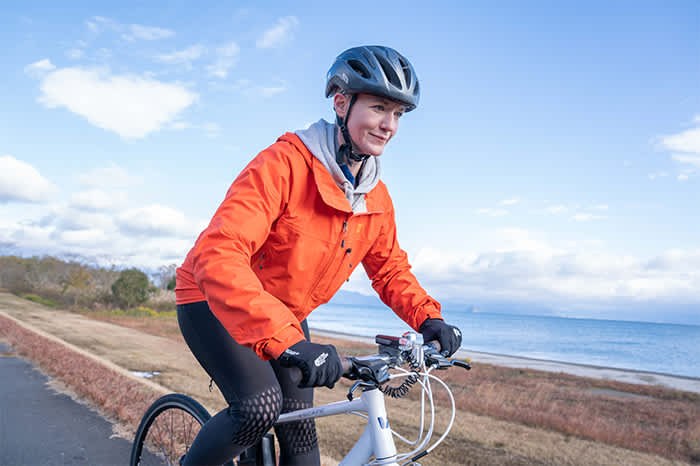
Biwaichi rental bicycle services
There are many bicycle rental stores around Lake Biwa, making Biwaichi a perfect route for beginner cyclists. There are multiple types of bikes to choose, from beginner-friendly cross bikes to full-fledged road bikes. Each store has different models of bicycles, prices, and systems, so be sure to rent a bike that suits you best.
Giant Store Biwako Moriyama

Giant Store Biwako Moriyama is a specialty store of the bicycle manufacturer Giant, and is located inside the Lake Biwa Marriott Hotel. A wide range of models and sizes are available for rent, mainly flat bar and drop road bikes.
MAIBARA CYCLE STATION
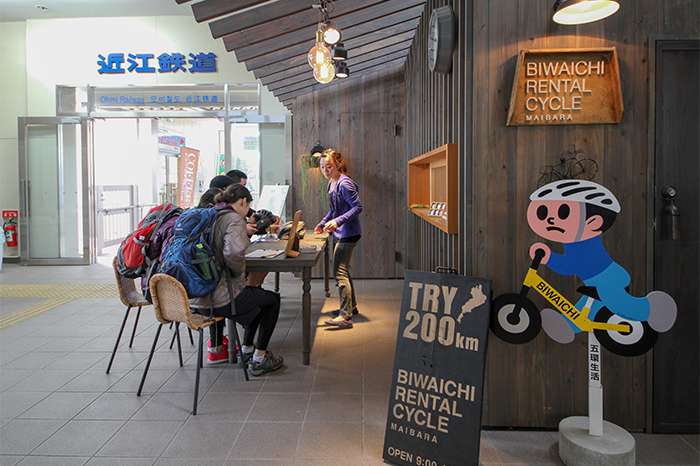
MAIBARA CYCLE STATION is located inside JR Maibara Station. Bicycles available to rent here are made by leading manufacturers from Japan and abroad, and there is also a shower room. For an additional fee you can drop off the rented bikes at one of the six designated spots around the prefecture (reservation required).




















































